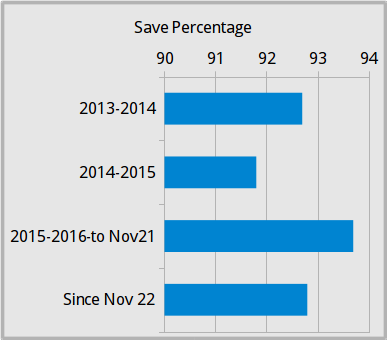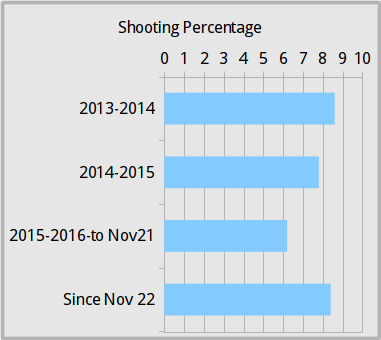Are you hungry for a really tasty high draft pick this summer? We just got to see a sampler of the top-ranked prospects in the World Junior Championships, and it's fun to window shop, but is a top pick a reasonable expectation?
I took a look at the Leafs' first quarter of this season—the games played up to November 21—the nearly complete second quarter since, and I compared them to the two previous years to get an idea of how the Leafs, with almost half a season under Mike Babcock, stack up against who they used to be.
Chance plays for every team.

Randomness, luck or PDO, as people like to call it, is behind a lot of what we see on the ice. I like to split PDO apart and look at its two completely unrelated parts: save percentage and shooting percentage.

The Leafs save percentage has gone up and down a little, and small changes are fairly significant here. The very good .924 from 13-14 fell down into average territory last year but popped up for the first quarter of this year into hey there territory. It's not a surprise that with injuries and Jonathan Bernier's struggles it's fallen a little.
Shooting percentage has shot up finally—finally!—in the second quarter from a very low 6.2% that was 24th in the league. It's now 16th.
This tells us that the Leafs aren't particularly lucky or unlucky at 5-on-5, and the previous poor shooting percentage luck has rebounded. It had a big impact in the first quarter because it resided largely in the body of Nazem Kadri. If it had been the whole fourth line that couldn't put it in, who would have cared?
Dance a little faster, guys.
The Leafs CP60 (shots for and against per 60 minutes) has shot up lately after dipping way down during Babcock's first months on the job. My eye-test says the Leafs succeed more with a balance of high-event play and defensive conservatism, and that just worrying about the shots against isn't enough. But then, higher event is more fun, so maybe my eye-test is fooling me.
They've gone from 11th after the first quarter to 4th in the league in CP60, so they aren't the Dallas Stars quite, but they aren't anything like the Detroit Red Wings either.
Moving on up.
Now the meat of it. The juicy, juicy percentages. I wish I could have Marilyn Monroe and some guys in cutaway tail coats dance on those stairs because they make me happy. If you're more of a fan of Bonnie Tyler and holding out for heroes, well, I have no good news for you.
Every marker of success, shot differential, scoring chances, zone starts, all of it is going up, up, up. Note how all of those bars for the second quarter are over 50%. That's where we want to be if we want to win.
Can we zoom in on that CF% a little?
There is very little correlation between shots for and shots against at the individual or team level. So splitting them apart to look at individually is usually a good idea.
With raw shots—Corsi for per 60 and Corsi against per 60—the Leafs' improvement is another set of steps going in the right direction. The scoring chances are a muddier picture, and that's not a surprise—it's less data, it should be seen as contextual shading of the Corsi numbers only—but it looks like with shots against, that between the first and second quarters of this year, the decline is in low-danger shots.
The large increase in shots for is also mostly low-danger shots. And it's not like that's bad. Low danger shots can go in—on any goalie, not just Jonathan Bernier, don't be mean. They just don't go in quite so often.
The Leafs are in 14th place in the league this year in Corsi Percentage, 9th in Scoring Chance Percentage, and 13th in Goals Percentage—mostly due to the first quarter's shooting percentage woes. They aren't playing like the Kings, the Stars or the Capitals, but they are playing way over their current 24th place in the standings.
I don't think the shields can hold, Captain.
This is all great, amazing and a lot of fun. Winning games by playing well makes for the best hockey to watch. But can it continue? I mean, not even another step up, but can they just maintain at this level?
The answer rests with who's on this team come the first day of March. Depending on how many current players get cashed in for picks or prospects, some of the guys delivering those juicy numbers might be replaced by rawer talents. I can draw you some charts of Marlies stats—I have—but will that performance convert to the NHL, and if it does, how soon?
If Mark Arcobello isn't on the Leafs on the regular now, he will be by then, so that's not getting worse, but what about guys like Connor Brown, William Nylander, Frank Corrado and Kasperi Kapanen? How will they play out of the gate?
It is possible that fans of high draft picks and marginally better lottery chances will get what they're wishing for? The Leafs may lose demoralizing game after game and sink in the standings like a cold stone. Can you tell I don't want that? I don't want that. If they lose valiantly, playing the system as hard as they can, that I'm happy to watch.
There are very good arguments in favour of losing for high picks, but I think it's possible there will be fewer trades than we might be expecting. I think the Leafs may decide some of their current roster works as a framework to build on, and some of their tastier trade bait might come in handy on draft day. I think it matters as much to have lots of picks than it does to have one really high pick, and the trade deadline isn't the only time you can get more.
Pick a number, any number.
Where will the Leafs finish? My guess is somewhere between 15th and 20th, which means picking between 10th and 15th unless the lottery coughs up a surprise.
But what about the P word?
Good question. For another day.
All data is from War on Ice, is 5-on-5, score adjusted and includes the regular season only. The data includes games played to January 6, 2016. Shots always refers to all shots, not shots on goal.

Comment Markdown
Inline Styles
Bold: **Text**
Italics: *Text*
Both: ***Text***
Strikethrough: ~~Text~~
Code: `Text` used as sarcasm font at PPP
Spoiler: !!Text!!